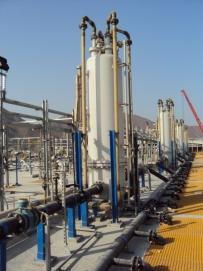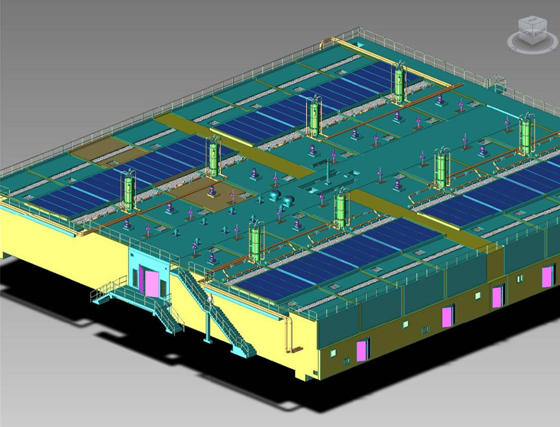Since 2005, Veolia Water Technologies has developed a rapid DAF process in its portfolio, named Spidflow®. This process responds to treatment needs in case of surface water containing low density particules, algae, floating matters (greases, oils...).
Overview
The flotation is made possible with a white water production (air and water mix under 5-6 bars) capable to generate fine air bubbles which are released in the system to occur the low density particules flotation.
The Spidflow® hydraulic design has been particularly optimized with the help of CFD (Computerized Fluids Dynamics) calculation simulations. Some hydraulic management devices, associated downstream to a coagulation/flocculation stage, allow Spidflow™ to reach high clarification rates in the range of 30 to 50 m/h.
APPLICATION RANGE
Spidflow® is applied for :
- drinking water treatment,
- sea water treatment (upstream to RO treatment systems), really efficient in case of red tides events
- process water production (power plants...)ase of surface water containing low density particules, algae, floating matters (greases, oils...).
SOME REFERENCES

- Cagnes-sur-mer WWTP, France, 2019, primary wastewater, 2,100 m3/h
- Cenal Energy Power Plant, Turkey, 2016, sea water, 120 m3/h
- Trégat DWTP, Brittany, France, 2016, dam water, 420 m3/h
- Oman Sur expansion, Sultanate of Oman, 2016, sea water, 5,417 m3/h
- Port Albert BWRO plant, Eastern Cape, Republic of South Africa, 2016, delta brackish water, 475 m3/h
- Sadara Chemical Complex, Kingdom of Saudi Arabia, 2016, sea water, 20,304 m3/h
- Narva DWTP, Estonia, 2015, surface water, 833 m3/h
- Al Zawrah 2, Ajman site, UAE, 2013, sea water, 4,974 m3/h
- Al Zawrah 1, Ajman site, UAE, 2013, sea water 2,984 m3/h
- Kermorvan DWTP, Brittany, France, 2013, surface water, 300 m3/h
- RWE Power plant, Netherlands, 2013, delta brackish water, 1,800 m3/h
- Fujairah 2, UAE, 2010, sea water, 15,375 m3/h
- Toulon La Valette DWTP, PACA, France, 2009, surface water, 2,823 m3/h
- Annet sur Marne, Ile de France, France, 2009, surface water, 103 m3/h
- Oman Sur, Sultanate of Oman, 2009, sea water, 2,224 m3/h
Applications
CHEMICALS
Usually, Spidflow® doesn't need polymer for the flocculation step, only in case of cold water; which is an advantage to produce very nice SDI (Silt Density Index) water quality in case of membranes uses downstream.
It's also possible to use PAC (Powdered Activated Carbon) continuously or during shorts events, in the Spidflow®. This is helpful in case of algal toxins release in the water by blue algae type (Cyanobacteria). The PAC is then a security step, capable of removing by adsorption the released toxins.



